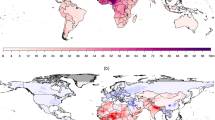Abstract
This paper presents an overview of the health benefits of controlling ambient air pollution in India. We answer five questions: First, how high is ambient air pollution in different parts of India? Second, what are the morbidity and mortality consequences of ambient and household air pollution? Third, what are the health costs of pollution-related morbidity and mortality? Fourth, what are the primary sources of ambient air pollution in India and what are their implications for policies to control air pollution? Finally, what are the health benefits and costs of reducing air pollution from coal-fired power plants?

Source: World Bank (2022)

Source: Members of the India State-Level Disease Burden Initiative Air Pollution Collaborators (2021)

Source: Author’s calculation from Global Burden of Disease Collaborative Network (2021)

Source: Author’s calculation

Source: Author’s calculation

Source: Members of the India State-Level Disease Burden Initiative Air Pollution Collaborators (2021)

Source: Author’s calculation

Source: World Bank (2022)

Source: World Bank (2022)

Source: World Bank (2022)

Source: Cropper et al. (2021b)

Source: Cropper et al. (2021a)

Source: Cropper et al. (2021a)

Source: Cropper et al. (2019)
Similar content being viewed by others
References
Burnett, R., Chen, H., Szyszkowicz, M., Fann, N., Hubbell, B., Pope, C. A., 3rd., & Apte, J. S. (2018). Global estimates of mortality associated with long-term exposure to outdoor fine particulate matter. Proceedings of the National Academy of Sciences. https://doi.org/10.1073/pnas.1803222115
Chakravarty, S., & Somanathan, E. (2021). There is no economic case for new coal plants in India. World Development Perspectives. https://doi.org/10.1016/j.wdp.2021.100373
Cropper, M. L., Guttikunda, S., Jawahar, P., Lazri, Z., Malik, K., Song, X.-P., & Yao, X. (2019). Applying benefit-cost analysis to air pollution control in the indian power sector. Journal of Benefit-Cost Analysis, 10(S1), 185–205. https://doi.org/10.1017/bca.2018.27. © Society for Benefit-Cost Analysis 2018. Published by Cambridge University Press. License: https://creativecommons.org/licenses/by/4.0/
Cropper, M. L., Guttikunda, S., Jawahar, P., Malik, K., & Partridge, I. (2017). Costs and benefits of installing flue-gas desulfurization units at coal-fired power plants in India. In Disease Control Priorities, Third Edition : Volume 7. Injury Prevention and Environmental Health. Washington, DC. © World Bank. https://openknowledge.worldbank.org/handle/10986/28576. License: Creative Commons Attribution CC BY 3.0 IGO
Cropper, M. L., Cui, R., Guttikunda, S., Hultman, N., Jawahar, P., Park, Y., et al. (2021a). The mortality impacts of current and planned coal-fired power plants in India. Proceedings of the National Academy of Sciences. https://doi.org/10.1073/pnas.2017936118
Cropper, M. L., Cui, R., Guttikunda, S., Hultman, N., Jawahar, P., & Park, Y. (2021b). The health impacts of coal-fired power plants in India and the co-benefits of GHG reductions. AEA Papers and Proceedings. https://doi.org/10.1257/pandp.20211034. © American Economic Association; reproduced with the permission of the AEA Papers & Proceedings.
Dey, S., Purohit, B., Balyan, P., Dixit, K., Bali, K., & Kumar, A. (2020). A satellite-based high-resolution (1-km) ambient PM2.5 database for India over two decades (2000–2019): Applications for air quality management. Remote Sensing. https://doi.org/10.3390/rs12233872
Global Burden of Disease Collaborative Network. (2021). Global burden of disease study 2019 (GBD 2019) particulate matter risk curves. Seattle, United States of America: Institute for Health Metrics and Evaluation (IHME), 2021. https://doi.org/10.6069/KHWH-2703
Greenstone, M., Pande, R., Sudarshan, A., & Ryan, N. (2022). The benefits and costs of emissions trading: Experimental evidence from a new market for industrial particulate emissions. Working paper.
Guttikunda, S., & Jawahar, P. (2014). Atmospheric emissions and pollution from the coal-fired thermal power plants in India. Atmospheric Environment, 92, 449–460. https://doi.org/10.1016/j.atmosenv.2014.04.057
IIASA. (2019). The GAINS model (greenhouse gas air pollution interaction and synergies model). Retrieved from http://gains.iiasa.ac.at
Members of the India State-Level Disease Burden Initiative Air Pollution Collaborators. (2021). Health and economic impact of air pollution in the states of India: The global burden of disease study 2019. 5(1), e25-e38. https://doi.org/10.1016/S2542-5196(20)30298-9. License: https://creativecommons.org/licenses/by/4.0/
Ministry of Environment, Forests and Climate Change Notification. (2015). Environment (Protection) Amendment Rules, December 8, 2015. Gazette of India. S.O. 3305(E).
Robinson, L. A., Hammitt, J. K., Cecchini, M., Chalkidou, K., Claxton, K., Cropper, M., et al. (2019). Reference case guidelines for benefit-cost analysis in global health and development. Harvard T.H. Chan School of Public Health, Center for Health Decision Science, Boston, MA.
World Bank. (2022). Striving for Clean Air: Air Pollution and Public Health in South Asia, World Bank, Washington, DC. License: Creative Commons Attribution CC BY 3.0 IGO. https://www.worldbank.org/en/region/sar/publication/striving-for-clean-air.
Funding
No funding was received to assist with the preparation of this manuscript.
Author information
Authors and Affiliations
Corresponding author
Ethics declarations
Conflict of interest
The authors have no competing interests to declare that are relevant to the content of this article.
Additional information
Publisher's Note
Springer Nature remains neutral with regard to jurisdictional claims in published maps and institutional affiliations.
Indian Economic Review public lecture, delivered on September 28, 2022 by Maureen Cropper, Professor of Economics, University of Maryland and Senior Fellow at Resources for the Future.
Rights and permissions
Springer Nature or its licensor (e.g. a society or other partner) holds exclusive rights to this article under a publishing agreement with the author(s) or other rightsholder(s); author self-archiving of the accepted manuscript version of this article is solely governed by the terms of such publishing agreement and applicable law.
About this article
Cite this article
Cropper, M., Park, Y. The health benefits of air pollution control in India. Ind. Econ. Rev. 57, 245–263 (2022). https://doi.org/10.1007/s41775-022-00149-6
Accepted:
Published:
Issue Date:
DOI: https://doi.org/10.1007/s41775-022-00149-6
Keywords
- Ambient air pollution
- Household air pollution
- Coal-fired power plants
- Air pollution in India
- Health effects of PM2.5




